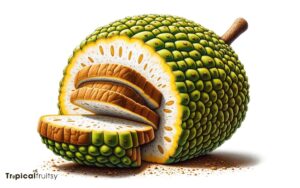What Does a Ripe Breadfruit Look Like? Explore!
A ripe breadfruit typically has a soft, creamy to yellow flesh with a sweet aroma. The skin may turn from green to yellowish, and the fruit’s surface may feel slightly giving when pressed.
The spikes on the surface become less pronounced, and some varieties may exude a small amount of latex.
To identify a ripe breadfruit, look for the following characteristics:
Remember that breadfruit ripeness can vary depending on the specific variety. Some may maintain a greener color even when ripe.
Identifying a ripe breadfruit ensures you’ll enjoy its maximum sweetness and creamy texture, essential for delicious tropical dishes.
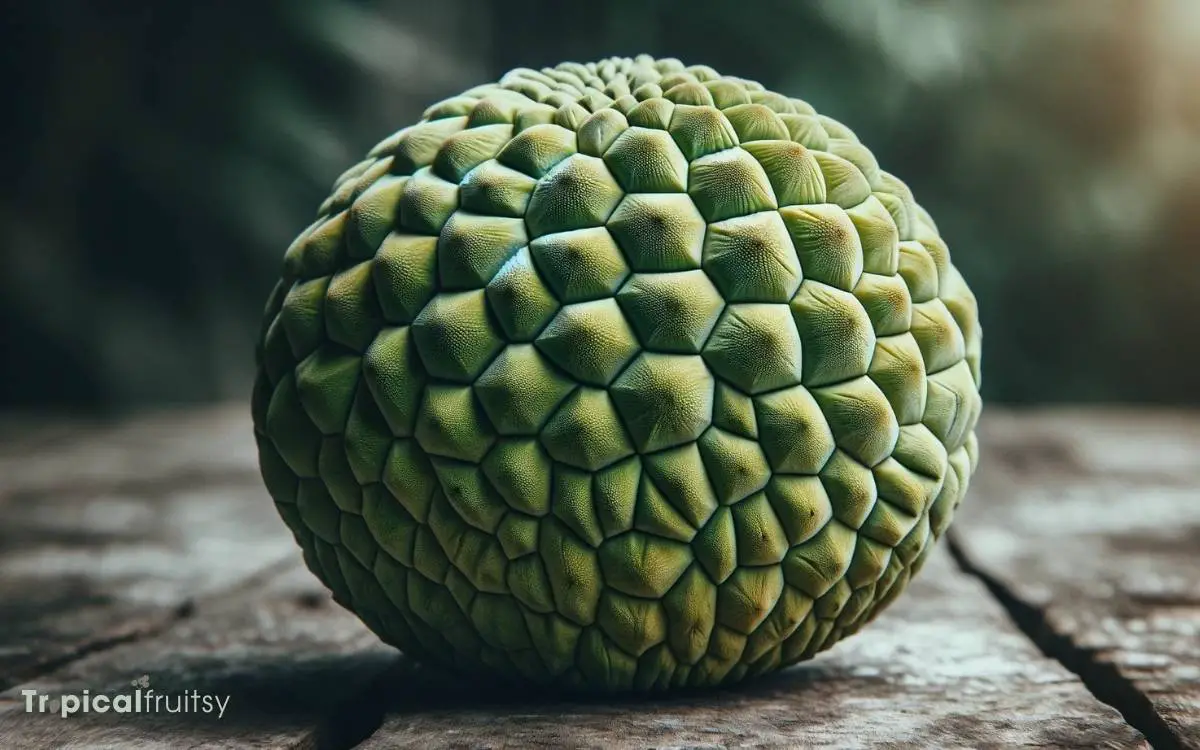
Key Takeaway
Identifying Ripe Breadfruit: Visual and Tactile Cues
| Characteristic | Description |
|---|---|
| Skin Color | Changes from green to yellowish-green or brown |
| Texture | Becomes slightly soft to the touch |
| Fragrance | Develops a sweet and pleasant aroma |
| Sound when tapped | Sounds hollow or emits a dull thud |
| Skin Appearance | May have small cracks or blemishes |
| Yielded to Gentle Pressure | Gives in slightly when pressed |
Identifying Color Changes

As breadfruit ripens, its skin transitions from a vibrant green to a yellowish-brown hue, indicating maturity. This chromatic alteration is a result of chlorophyll breakdown within the pericarp, the fruit’s outer layer.
Concurrently, there is an accumulation of carotenoid pigments, which contribute to the yellowing effect.
The phenological phase of the breadfruit, marked by this color shift, is crucial for determining harvest time.
Ethylene production, a hormone responsible for the ripening process in many fruits, escalates during this period, promoting further biochemical transformations within the breadfruit.
These include softening of the flesh and modifications in starch composition, which affect both texture and taste.
Understanding these visual and biochemical cues is essential for optimal harvesting, ensuring the fruit’s edibility and palatability.
Feeling for Softness
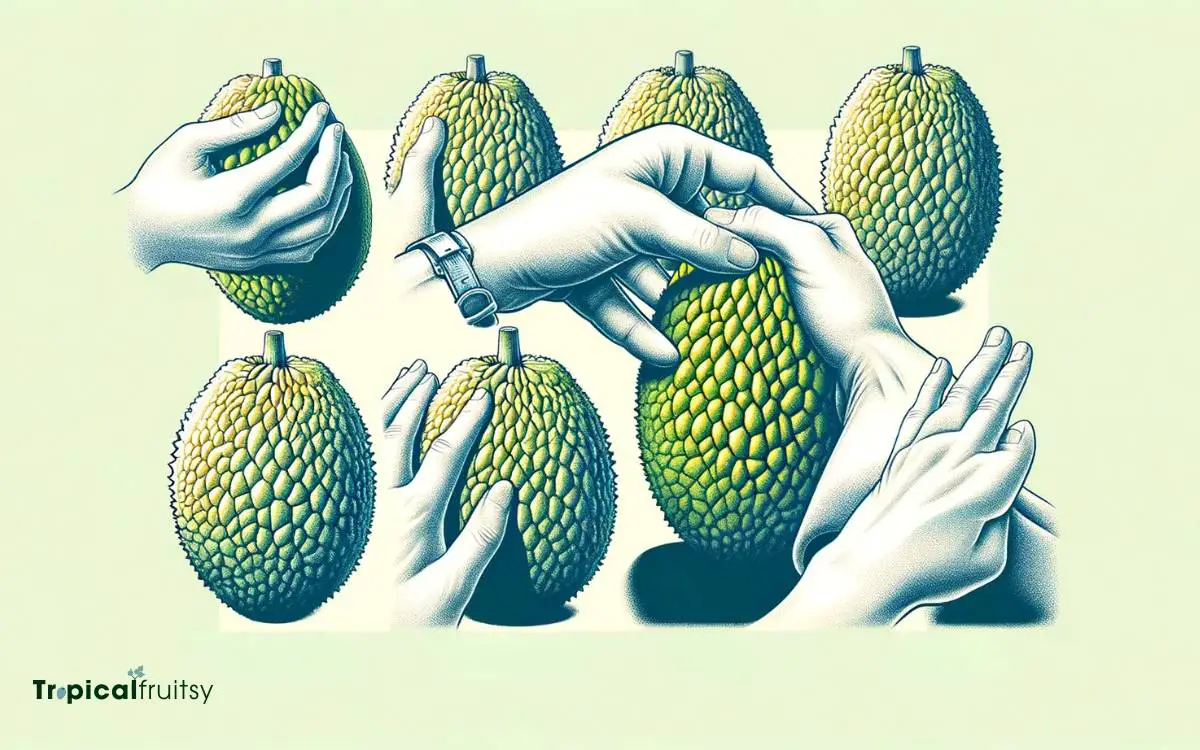
Upon examination for ripeness, the pressure test technique is a critical assessment method for determining the softness of breadfruit.
This tactile evaluation involves applying a gentle, consistent force to the surface of the fruit to gauge the presence of ripeness indicative softness, which is characterized by a slight yield under pressure.
Variability in firmness at different stages of maturation necessitates a precise understanding of the textural changes that occur as the breadfruit transitions from unripe to ripe.
Pressure Test Technique
Employing the pressure test technique, a ripe breadfruit typically yields slightly to the touch, indicating its readiness for consumption. This tactile assessment is a crucial non-destructive method for evaluating the fruit’s maturation.
The test involves a gentle application of pressure using the thumb or fingers on the surface of the breadfruit. Observing the physical response, one should note the degree of resistance offered by the breadfruit’s pericarp.
A firm resistance suggests under-ripeness, while excessive softness indicates over-ripeness or spoilage.
The optimal condition is identified by a subtle give under pressure, without compromising the structural integrity of the fruit.
This phenological indicator correlates with the biochemical changes within, such as starch conversion to sugars, which contribute to the desired taste and texture profiles.
Ripeness Indicative Softness
Many breadfruits, when ripe, exhibit a distinct softness that can be detected through careful palpation. This tactile evaluation involves applying gentle, yet firm pressure to the surface of the fruit to gauge its compliance.
The ripeness indicative softness results from the conversion of starches within the breadfruit to simpler sugars, a process mediated by the enzymatic activity that increases as the fruit matures.
This biochemical transformation leads to a degradation of the middle lamella, softening the cell walls and altering the textural properties of the fruit’s parenchyma.
A mature breadfruit typically yields to moderate pressure, indicating the peak stage for consumption.
However, excessive softness may suggest overripeness, with potential compromises to structural integrity and flavor profile.
Firmness Variability Stages
The firmness of a breadfruit undergoes discernible changes as it progresses through various stages of ripeness, providing a tactile method for assessing its maturity. Initially, an unripe breadfruit exhibits a rigid, inflexible exterior that resists pressure.
As maturation ensues, pectin substances within the cell walls of the fruit begin to break down, a process known as pectinolysis, which results in a gradual softening.
The penultimate stage is characterized by a yielding yet resilient feel when moderate pressure is applied, indicating an approach to optimal ripeness.
At peak ripeness, the breadfruit’s firmness further diminishes, reaching a pliant, almost spongy consistency. This textural transformation serves as a reliable indicator for harvest readiness.
Noticing Skin Texture
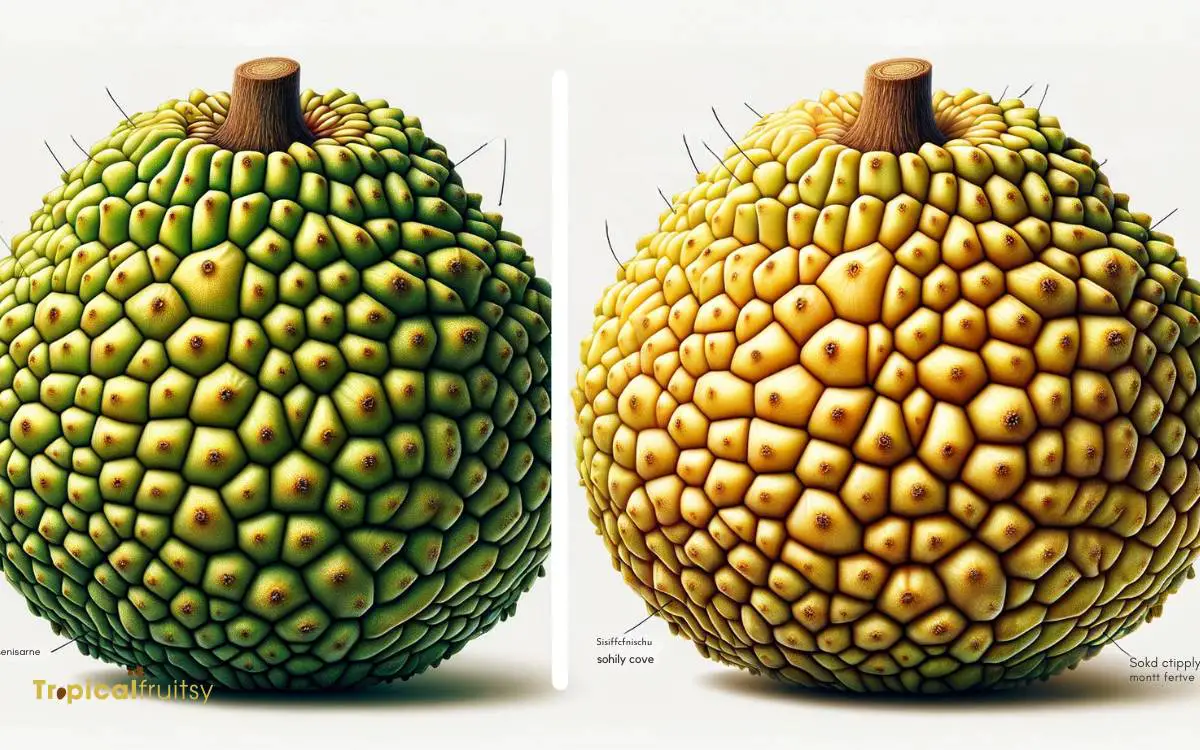
Examine the skin of the breadfruit closely, as a ripe one typically exhibits a soft, smooth texture with small, shallow indentations. The cutaneous surface of the breadfruit is indicative of its maturity and palatability.
- Surface Smoothness: A mature breadfruit will have a predominantly smooth epidermis, with a supple quality when palpated.
- Indentation Presence: Look for the characteristic pattern of small, shallow depressions across the skin, which are subtle but discernible.
- Skin Elasticity: Gently pressing on the skin should yield slightly, indicating the internal starches have developed adequately.
- Color Consistency: While not directly a textural attribute, a uniform hue without green patches often accompanies the textural readiness of the breadfruit.
For optimal edibility, these textural nuances are crucial in conjunction with visual and tactile assessments.
Checking for Stem Sap
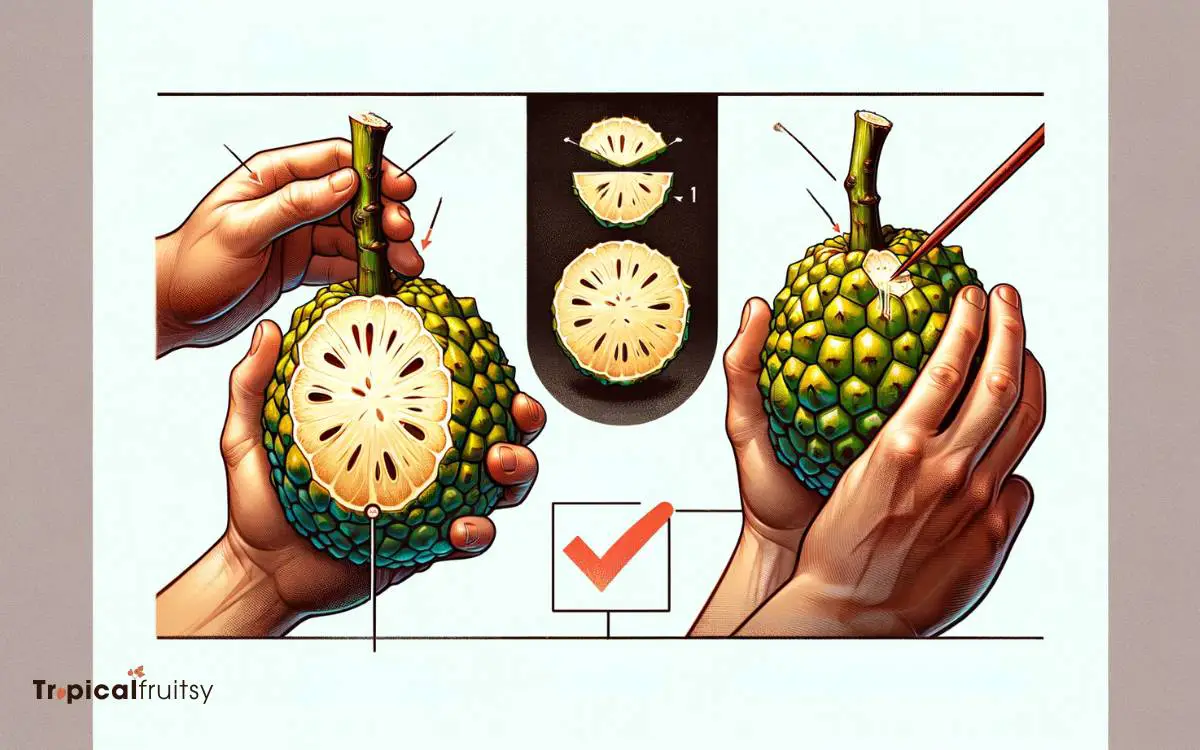
How does the presence of sap at the stem indicate the ripeness of a breadfruit?
The exudation of sap from the peduncle, or stem, of breadfruit is a physiological marker of maturation.
This sap comprises a blend of organic compounds, including sugars, minerals, and phytohormones, which reflect the metabolic state of the fruit.
As the breadfruit ripens, enzymatic activity within the fruit’s tissues leads to the breakdown of complex carbohydrates and other macromolecules, which can trigger sap release.
The sap’s appearance—usually a sticky, latex-like substance—can serve as an empirical indicator of ripeness when observed in conjunction with other ripeness cues.
A farmer or consumer can gauge the optimal harvest time by checking for this sap, ensuring that the breadfruit has reached a desirable level of maturity for consumption or processing.
Smelling the Aroma

Upon reaching maturity, a breadfruit emits a distinctive fragrance that serves as a key indicator of its ripeness.
This olfactory cue is characterized by a sweet, tropical aroma that results from complex biochemical processes within the fruit, involving the breakdown of starches into simpler sugars and the production of aromatic compounds.
Sensory evaluation of this aroma can be used as a non-destructive method to assess ripeness, complementing visual and tactile examinations.
Identifying Sweetness
One can often gauge the ripeness of a breadfruit by its distinct, sweet aroma. As the fruit matures, biochemical processes within the breadfruit cause the production of volatiles that contribute to its characteristic fragrance.
These aromatic compounds are complex and can include esters, alcohols, and terpenes, which are indicative of the fruit’s sweetness level.
For a more scientific approach to identifying the ripeness through aroma, consider the following:
- Observe for a pronounced fruity smell, signifying high ester content.
- Note the absence of green, grassy notes, which diminish as ripeness progresses.
- Assess for overtones of floral scents, a marker of mature fruit.
- Detect the underlying musky scent, pointing to the presence of ripe-specific terpenes.
These olfactory cues serve as reliable indicators of the breadfruit’s sweetness.
Aroma Changes
The maturation of breadfruit is accompanied by a noticeable shift in its aromatic profile. It transitions from subtle to more pronounced fruity and floral notes as the fruit reaches full ripeness.
Volatile organic compounds (VOCs), which are responsible for the fruit’s fragrance, increase in complexity and concentration during the ripening process.
Specifically, the production of esters, known for their sweet and fruity aromas, is significantly enhanced. Additionally, the presence of compounds such as ethyl hexanoate and ethyl octanoate contribute to the fruit’s distinct smell.
As enzymatic reactions break down cellular components, these aroma compounds are released. This release of aroma compounds can serve as a sensory indicator of the breadfruit’s maturity.
Thus, olfactory assessment is a viable method for determining the ripeness of breadfruit.
Sizing Up the Weight
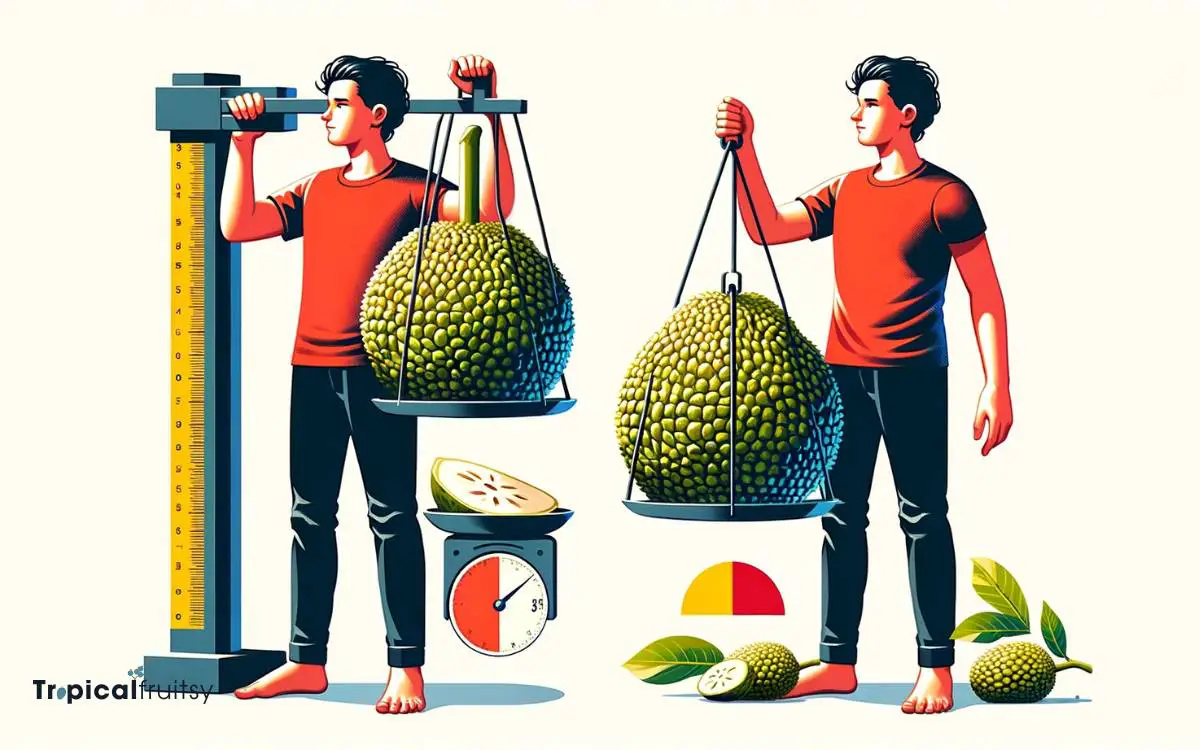
Ripe breadfruit typically reaches a substantial mass, with mature specimens weighing between 1 to 6 kilograms depending on the variety and growing conditions. This variation in weight is attributable to several factors that influence fruit development.
- Genetic Variability: Different cultivars of breadfruit have distinct genetic profiles, which determine potential size and weight.
- Nutrient Availability: Optimal soil fertility and access to essential nutrients like nitrogen, phosphorus, and potassium contribute to maximal fruit growth.
- Water Supply: Adequate hydration is crucial during the fruit’s development period, impacting its final weight.
- Climatic Conditions: Temperature, humidity, and sunlight exposure can significantly affect the rate of photosynthesis and thus the accumulation of biomass within the fruit.
Understanding these parameters is essential for cultivators aiming to maximize yield and for consumers seeking quality produce.
What Does the Appearance of Ripe Breadfruit have to do with its Taste?
The appearance of ripe breadfruit is crucial in exploring breadfruit taste variations. A ripe breadfruit should have a yellowish color and yield slightly to pressure when touched. Its taste can range from sweet to starchy, depending on its ripeness. This is why appearance is a good indicator of its potential taste.
Spotting the Splotches
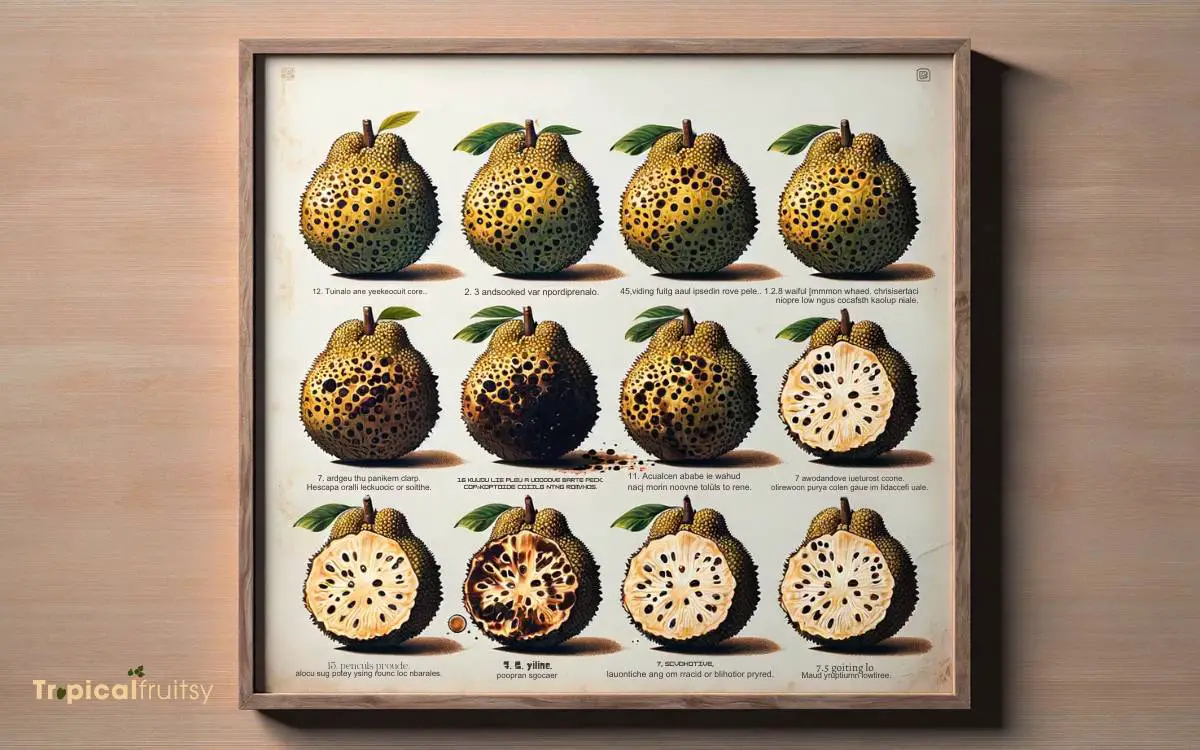
Several small, dark splotches on the skin of a breadfruit indicate that it has reached peak ripeness. These markings are the result of pigment changes that occur as the starches within the fruit convert to sugars.
The splotches are a visual cue to the biochemical processes at work and their presence is an essential indicator in determining the optimal time for harvest.
Their appearance is typically associated with a softening of the fruit’s texture, which is another ripeness indicator.
For a detailed understanding, observe the following table:
| Skin Feature | Ripeness Indication |
|---|---|
| Color | Transitions to a yellow-green hue |
| Texture | Yields slightly to pressure |
| Splotches | Dark, irregular spots appear |
| Odor | Emits a fragrant, sweet smell |
These characteristics are reliable markers to discern the ripeness of breadfruit.
Conclusion
The identification of a ripe breadfruit is a multifaceted process. It involves observation of color transitions to a yellowish hue and tactile assessment for increased softness.
Additionally, examination of skin texture for smoothness and verification of latex exudation from the stem are important factors.
Olfactory evaluation for a sweet aroma is another indication of ripeness. Furthermore, the consideration of a heavier weight and the presence of brown splotches are important indicators.
Remarkably, a single tree can yield up to 200 fruits per year. This makes breadfruit a significant, yet often overlooked, source of sustenance in tropical regions.




